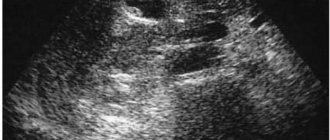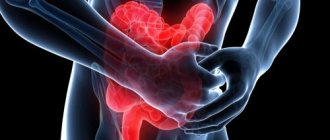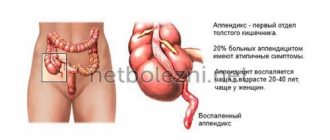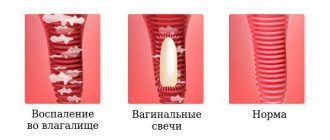© Author: Z. Nelly Vladimirovna, doctor of the first qualification category, especially for SosudInfo.ru (about the authors)
Intestinal vascular thrombosis is not a disease of young people; it affects middle-aged and elderly people. This is explained by the fact that atherosclerotic changes in the vascular walls develop and progress throughout life. Intestinal infarction, acute arterial or venous insufficiency are pathological conditions that have different etiologies and development mechanisms, but lead to acute disorders of the blood supply to the intestinal tract. The two main types of circulatory disorders (arterial and venous) can form a mixed form, which occurs in particularly advanced cases.
Impaired blood supply to the intestines
Scheme of abdominal blood supply
With mesenteric thrombosis, in approximately 90% of cases, the superior mesenteric artery, which supplies blood to most of the intestine (the entire small intestine, cecum, ascending colon, 2/3 of the transverse colon and hepatic angle), is affected, therefore the violations here are the most severe. The share of lesions of the inferior mesenteric artery, which supplies blood to 1/3 of the transverse colon (left), descending colon and sigmoid, accounts for about 10%.
Acute mesenteric arterial insufficiency (AMI) can be of organic origin, resulting in occlusion of the great vessels, or of a functional nature, in which no changes in the lumen are observed.
In cases of organic lesions, the lumen of the mesenteric vessels is blocked primarily and the cause of this is trauma and embolism. Secondary overlap occurs as a result of thrombosis, which, in turn, was the result of long-term progressive changes in the vascular wall or outside it.
The most severe forms of impaired blood supply to the intestinal tract are embolisms and injuries of mesenteric vessels, which is explained by the lack of previously prepared developed collateral blood flow, and, consequently, the lack of compensation for the disturbed main blood flow.
Etiology
Unfortunately, today absolutely no one is immune from this disease. However, doctors name a number of predisposing factors that primarily provoke the development of a pathology such as intestinal thrombosis. The reasons may be as follows:
- Atherosclerosis (vascular disease characterized by the sequential formation of plaques, the rupture of which leads to the formation of blood clots).
- Myocardial infarction.
- Hypertension (high blood pressure).
- Thrombophlebitis (an inflammatory process localized in the veins of the legs and accompanied by stagnation of blood).
- Endocarditis (inflammation of the inner lining of the heart, leading to the formation of blood clots).
- Sepsis (blood poisoning).
- Rheumatism (a disease affecting the connective tissue, resulting in the development of heart disease).
- Postpartum thrombosis.
Often, for example, thrombosis of the small intestine develops immediately after surgical manipulations on other organs. However, in this case, the patient has a greater chance of survival, since for some time after the operation he is under close medical supervision. In such situations, the specialist immediately makes a decision on treatment. An anticoagulant or any other drug that dilutes the clot is administered.
Causes of primary disturbance of arterial blood flow
The causes of embolism are directly related to heart disease:
- Mitral valve stenosis;
- Heart rhythm disturbances;
- Cardiac aneurysm;
- Myocardial infarction, in which there is a marked decrease in the contractility of the left ventricle. An embolus (blood clot) in this case is formed as a result of increased blood clotting due to a disturbance in the speed of blood flow. A blood clot in the mesenteric arteries comes from the aorta, but sometimes it can form in the mesenteric vessel itself, although very rarely.
Injuries to the mesenteric arteries can lead to their complete rupture (a blow to the abdomen), which results in exfoliation of the intima, which, in turn, can completely or critically block the lumen.
Secondary occlusion of mesenteric arteries
The causes of secondary mesenteric insufficiency are the following pathological conditions:
- Stenosis of atherosclerotic origin (most often) at the mouth (place of origin) of arteries, because a large vessel departs from the aorta at an acute angle, creating conditions for the occurrence of turbulent blood flows. With a sharp decrease in blood flow, which happens when the artery narrows by more than 2/3 (considered a critical indicator), thrombosis of the mesenteric vessels is possible. Similar events occur when an atherosclerotic plaque ruptures or is damaged with complete obstruction (closure) of the lumen of the vessel. This will inevitably entail necrosis of the tissues that this vessel provides with blood, therefore atherosclerosis of the mesenteric arteries accounts for the largest percentage of cases of intestinal vascular thrombosis;
- Tumors, rudiments of the peduncle of the diaphragm and fibers of the celiac plexus, which lead to compression of the artery;
- A drop in cardiac activity with a pronounced decrease in blood pressure;
- Surgical (for the purpose of reconstruction) interventions on the aorta, the reason for which was its blockage - steal syndrome. When a blood clot is removed, blood begins to rush into the lower extremities at high speed, partially bypassing the mesenteric arteries and at the same time “sucking” blood from them into the aorta. In conditions of mesenteric obstruction, multiple thromboses with intestinal necrosis or intestinal infarction with subsequent perforation develop, while the main trunks of the mesenteric artery may not be thrombosed.
The etiological factors of acute mesenteric thrombosis of the intestine, or rather its arteries, can be different, but the mechanism for the development of pathological changes is always the same - intestinal ischemia.
Forms of intestinal ischemia
The clinic of intestinal ischemia differs in 3 degrees of severity, which are directly dependent on the diameter of the damage to the main arteries and collateral blood flow:
- Decompensated ischemia is the most severe form of damage to arterial vessels, in which irreversible effects can quickly occur if the time to restore blood flow is missed. It is characterized by absolute ischemia (decompensation of the intestinal blood supply disorder) and occurs in 2 phases. A period of time up to 2 hours is considered a phase of reversible changes. A phase lasting 4-6 hours is not always reversible; the prognosis can become unfavorable overnight, since after this time gangrene of the intestine or part of it inevitably occurs and then restored blood flow no longer solves the problem;
- Subcompensated disruption of the blood supply to the intestine provides collateral blood flow and in this case the symptoms of thrombosis of the intestine (its vessels) resemble the chronic form of mesenteric arterial insufficiency;
- The compensated form is chronic intestinal ischemia, when collaterals completely take care of the main blood flow.
Pathogenesis
The pathogenesis of thrombosis has been studied and is well described by Virchow's triad. The main links in thrombus formation are: damage to the vascular endothelium, changes in blood flow and hypercoagulation (violation of the rheological properties of blood), the development of each of which has its own reasons.
The formation of intravital blood clotting in a vessel occurs in several stages and includes platelet agglutination, fibrinogen coagulation, erythrocyte agglutination and precipitation of plasma proteins.
Clinical manifestations of intestinal vascular thrombosis
Symptoms of intestinal thrombosis depend on the height of the overlap of the mesenteric artery and the form of ischemia:
- Sudden, rather intense pain is most characteristic of the subcompensated form of ischemia, although with decompensation of the blood supply disorder it also occurs, but soon weakens due to the death of nerve endings (at the site of the intestinal lesion and in the mesentery itself), which cease to signal trouble in the body (imaginary improvement );
- Intoxication caused by intestinal gangrene is especially characteristic of decompensated ischemia and is manifested by a thready pulse, unstable blood pressure, significant leukocytosis and vomiting;
- The phenomena of peritonitis (pronounced tension of the abdominal wall reminiscent of a perforated gastric ulcer) are most characteristic of thrombosis of the small intestine (superior mesenteric artery) in the case of the development of gangrene and intestinal perforation, which often occurs against the background of decompensated and subcompensated ischemia;
- The disappearance of intestinal motility (with intestinal necrosis) is inherent in decompensated ischemia, while in subcompensated ischemia, on the contrary, it has high activity and clarity;
- Passage disorder (frequent loose stools) and intestinal colic accompany the compensated form, with an admixture of blood - subcompensated ischemia. Due to the cessation of peristalsis in decompensated circulatory disorders, an enema (blood in the stool) is necessary to evaluate stool.
It should be noted that before the development of thrombosis of the intestinal arteries, it is possible to establish a diagnosis of acute mesenteric arterial insufficiency. The following signs may indicate impending thrombosis of mesenteric vessels:
- Abdominal pain that gets worse after eating or walking for a long time;
- Unstable stool (constipation, diarrhea, their alternation);
- Weight loss (may indirectly indicate the onset of a stenotic process at the mouth of the mesenteric artery).
Embolism of the superior mesenteric artery, on the contrary, is characterized by the absence of this symptom complex.
Forecast
Mesenteric thrombosis, according to clinical studies, is observed much more often than the number of cases diagnosed. This pathology is masked by various acute conditions: cholecystitis, renal colic, appendicitis. The limited time for diagnosis does not always allow the disease to be detected.
Fatal cases, according to pathologists, are 1–2.5% of hospital mortality. These are thrombosis in the stage of infarction and diffuse peritonitis. Late surgery (after 12 hours) means high mortality (up to 90%).
A good prognosis for recovery with surgical treatment of chronic thrombosis in the first two stages. Timely seeking surgical help for abdominal pain allows the patient to be operated on in a favorable time frame and prevent perforation of the intestinal wall.
Diagnosis of mesothrombosis
With the correct diagnostic approach, it is possible not only to determine the disorder of the intestinal blood supply itself, but also the reasons that caused it. In this regard, collecting anamnesis and asking the patient about the course of the disease plays an important role. Clarifying the time of onset of pain, its intensity, and the nature of stool can significantly help the doctor in choosing surgical treatment, since there is still no other alternative in the case of mesothrombosis.
Diagnosis of OMAN involves selective angiography, which makes it possible to determine the level and nature of artery blockage, which will also be important for providing emergency care, naturally, in the form of surgical intervention.
The laparoscopic method still remains decisive in any type of acute surgical pathology, where mesothrombosis is no exception. Rather, on the contrary, in case of a decompensated circulatory disorder, the surgeon has only 2 hours at his disposal, so it is clear that there is no need to delay the diagnosis. With the help of laparoscopy, it is possible to clarify the nature of the damage to the intestinal tract within a short time.
Only a radical method that cannot be postponed
Conservative treatment of intestinal thrombosis, that is, the mesenteric arteries that supply it with blood, is unacceptable , however, mesenteric insufficiency can begin to develop suddenly, which is always aggravated by the total spasm of blood vessels that accompanies the disease.
With the active administration of antispasmodics, it is possible not only to alleviate the patient’s suffering, but also to transform a more pronounced degree of ischemia into a less severe one. However, the progression of mesothrombosis leads to the blocking of important collaterals, which significantly aggravates the patient’s condition, due to the fact that they cease to compensate for the blood supply. If we proceed from this position, then a violation of the blood supply to the intestines in each specific case may have its own “surprises”, which very significantly affect the outcome of the surgical intervention.
Emergency care in the form of surgical treatment of mesenteric thrombosis is the only way to save a human life, however, the general set of measures provides for intensive preoperative preparation, which corrects disturbances of central hemodynamics.
Surgery for intestinal thrombosis consists of the required components:
- Inspection of the intestine and palpation of the mesenteric vessels, starting from the mouth;
- Determination of pulsation in the mesenteric arteries at the borders of the affected intestine, where in cases of doubt, dissection of the mesentery is considered appropriate (establishing arterial bleeding).
The actual liquidation of OMAN may include the following methods of carrying out the operation:
- Complete restoration of blood flow in the absence of intestinal necrosis;
- Improving blood supply to the subcompensation site in case of bowel changes;
- Resection of the changed intestine.
In order to improve or restore blood supply, reconstruction of the great arteries or embolectomy is used, which is considered a fairly effective method. In this case, the surgeon can “milk” the embolus with his own fingers.
embolectomy for mesothrombosis
Reconstructive surgery in the form of direct intervention in the area of stenosis and thrombosis or the creation of a shunt between the mesenteric artery and the aorta below the level of stenosis and thrombosis (less traumatic) is performed in case of blockage of the artery lumen by a thrombus and is carried out according to emergency indications. The gangrenous intestine is cut off from healthy tissue and removed, but in this case, great importance is attached to restoring blood flow, because by limiting only to resection, the doctor always risks losing the patient (this situation results in up to 80% of deaths).
In addition, in the postoperative period, in addition to a set of generally accepted measures, patients are prescribed anticoagulants (heparin). However, if blood flow is not restored, then it becomes necessary to use high doses of heparin. This is fraught with such consequences as failure of the anastomotic sutures, which occurs due to the fact that the level of fibrin, the task of which is to glue the peritoneum, drops sharply.
Video: mesenteric ischemia - diagnosis, explanation and operation
Thrombosis of mesenteric veins and mixed form of acute circulatory disorder
The cause of acute mesenteric venous insufficiency (AMVI) is most often thrombosis of venous vessels, involving an entire segment of the intestinal mesentery. This is usually due to an excessive increase in blood coagulation and impaired peripheral and central hemodynamics.
The clinical picture of intestinal venous thrombosis has the following symptoms:
- Severe pain localized in a specific area of the abdomen;
- Frequent loose stools mixed with blood or bloody mucus;
- The phenomena of peritonitis appearing as necrotic changes in the intestine develop.
Diagnosis is based on history, clinical picture and laparoscopic examination.
Treatment consists of removing the affected intestine within healthy tissue.
The prognosis for venous thrombosis, in contrast to arterial blood supply disturbances, is favorable. The intestinal loops, while continuing to be supplied with arterial blood, are completely affected very rarely.
The mixed form, in which thrombosis of an arterial vessel occurs simultaneously in one segment of the intestine and a venous one in another, is considered in its pure form to be an extremely rare phenomenon, which is usually detected during surgery.
List of sources
- Pokrovsky A.V., Yudin V.I. Acute mesenteric obstruction // Clinical angiology: Guide / Ed. A. V. Pokrovsky. T. 2. M.: Medicine, 2004. P. 626-645.
- Savelyev V. S., Spiridonov I. V., Boldin B. V. Acute disorders of mesenteric circulation. Intestinal infarction: Guide to emergency surgery / Ed. B. S. Savelyeva. M.: Triada-X, 2004. pp. 281-302.
- Solomentseva T. A. Acute disorders of mesenteric circulation in a therapeutic clinic // Acute and emergency conditions in medical practice. 2011. No. 2. P. 8-14.
- Yushkevich D.V., Khryshchanovich V.Ya., Ladutko I.M. Diagnosis and treatment of acute disturbance of mesenteric circulation: current state of the problem // Med. magazine 2013. No. 3. P. 38-44.
- Katerina J.M., Kahan S. Emergency Medicine: Trans. from English - M.: MEDpress-inform, 2005. - 336 p.









